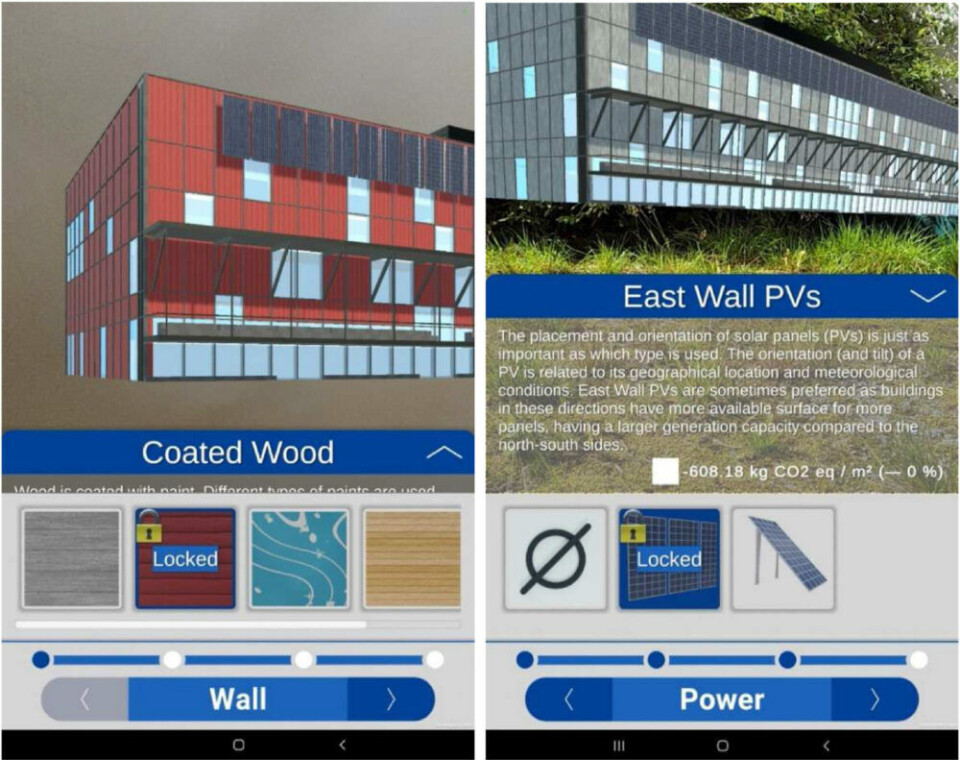THIS CONTENT IS BROUGHT TO YOU BY SINTEF - read more
Can an app make us more engaged in environmentally friendly architecture?
Researchers believe that visualisation using augmented reality can help.

Researchers at SINTEF and NTNU recently developed an app that can add an extra digital layer to the real world, providing users with a more interactive and engaging experience.
“Our aim was to find out whether this could increase people’s understanding, interest, and commitment to sustainable architecture. We thought it was fantastic,” says Claudia Moscoso, research manager at SINTEF.
Augmented reality (AR) adds a digital layer of information and illustrations on top of the real world.
The new AR app can show how different façade materials on a sports hall in Oslo may affect CO2 emissions.
Simulation of a sports hall
The study, which is part of the EU project ARV, was conducted at Voldsløkka secondary school and cultural centre.
Voldsløkka school opened in 2023 and is the first energy-plus school in Oslo. An energy-plus school is a school building that produces more energy than it consumes, often using renewable energy sources such as solar panels. The goal is to reduce its carbon footprint.
A sports hall that has not yet been built was used as a simulated building in the app. This enabled participants to see the hall in its future environment.
The visual information, taken from the real urban background, ensures a better understanding of the building in its context.
“In this way, the participants saw what the building would look like with different façade materials, and how using different materials would affect the sustainability of the building,” explains Moscoso.

Both laypeople and experts participated
27 men and women aged between 22 and 63 took part in the study. Using the AR app, they could explore how different façade materials would affect the sports hall’s CO2 emissions.
These materials included five types of exterior cladding and two types of window glass. Different placements for integral solar cells were also explored.
Afterwards, the participants were asked to evaluate the app based on usability, usefulness, and realism. They also answered questions about their own understanding, interest, and commitment to sustainability issues.
An effective tool
The results showed no significant differences between men and women or between experts and non-experts. This applied both to their assessment of the app and their level of interest in the environment.
One finding stood out: When the perceived user-friendliness and usefulness of the AR app was considered to be higher, the level of understanding, interest, and commitment to sustainable architecture was also higher.
The greater the interest, the greater the willingness to engage.
However, while technology can generate interest in a topic, it is only the first step.
“To turn interest into real engagement and action, we need to know what we are doing. Technological solutions must be user-friendly, useful, and realistic, and they must be incorporated into a comprehensive strategy for citizen engagement,” says Moscoso.
The road ahead
The results from the study are being further developed by researchers at SINTEF’s VR lab. Here, researchers work with both VR and AR technologies to increase the level of engagement among citizens both in Norway and abroad.
“Our researchers and developers are now working to create a VR tool to showcase the sustainable choices made for Voldsløkka school. We will also be creating a new version of the AR tool to increase the environmental engagement among residents of the city of Palma, Mallorca,” says Moscoso.
“We strongly believe that these technologies will help people gain a greater understanding and enthusiasm for the field of sustainable architecture and cities,” she says.
Reference:
Moscoso et al. Increasing citizen engagement in sustainable architecture using augmented reality: A pilot study, Computers in Human Behavior Reports, vol. 16, 2024. DOI: 10.1016/j.chbr.2024.100498
———
Read the Norwegian version of this article on forskning.no
More content from SINTEF:
-
New study: Even brand-new apartments in cities can have poor indoor air quality
-
Fresh hope for patients with chronic inflammatory bowel disease
-
Testing a giant ship: May take five kilometres to stop
-
A robot is helping researchers hunt for the best cancer warriors
-
Locomotives that run on diesel can be electrified
-
Where kelp is being turned into lab-grown meat





































